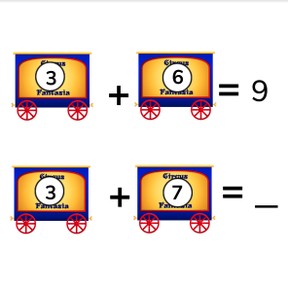



8,000 schools use Gynzy
92,000 teachers use Gynzy
1,600,000 students use Gynzy
General
Students learn to add to 20 in problems where they either add one more or take one away to find their total.
Standards
-1.OA.C
Introduction
Make a number snake with the students in the classroom. Start the snake at number 10, and have them count on by ones until they reach 20. You can repeat this a few times with different heads for the snake. Next, students must indicate what the neighbor numbers of the given numbers are.
Instruction
Show the highlighters on the interactive whiteboard. Say that there are 14 markers and that 4 more are added. Together that makes 18. Discuss the other addition problems represented by the markers. Ask students if they notice anything about the totals of these problems. Say that one highlighter is added every time. Sometimes you cannot see the images to count them. Sometimes you only see the numbers. Compare the addition problems. If the first addend of the second problem is one more than the first addend of the first problem then the total is also one more. Show examples on the interactive whiteboard. Ask how they determine the answer to the second and third addition problems. Did they do the calculations again or did they just add one more? Tell students that if the second addend of the second problem is one more than the second addend in the first problem, then the answer is also one more. Practice the problems that demonstrate this. Continue to practice this skill with one less.
Check that students understand adding to 20 with one more or one less by asking the following questions/giving the following questions:
- What do you need to look at to decide if you add with one more or one less?
- Calculate the following: 10+7= and 10+8=
- Calculate the following: 4+8= and 4+7=
Quiz
Students first practice calculating addition with one more or one less by selecting a multiple choice answer. Then they must give their own answer to an addition problem with one more or one less. Finally, they must practice addition with one more or one less as well as making tens to solve for their answer.
Closing
Show the table on the interactive whiteboard. Explain how to read the table and then ask students to complete the table.
Teaching tips
Students who have difficulty with adding with one more or one less can make use of MAB blocks or other manipulatives. Have them set out blocks to represent the addition problem. Then ask them to demonstrate a problem with one more or with one less by moving one block to one of the groups or by taking one away.
Instruction materials
Optional: blocks or manipulatives
The online teaching platform for interactive whiteboards and displays in schools
Save time building lessons
Manage the classroom more efficiently
Increase student engagement
Discover more!
About Gynzy
Gynzy is an online teaching platform for interactive whiteboards and displays in schools.
With a focus on elementary education, Gynzy’s Whiteboard, digital tools, and activities make it easy for teachers to save time building lessons, increase student engagement, and make classroom management more efficient.



